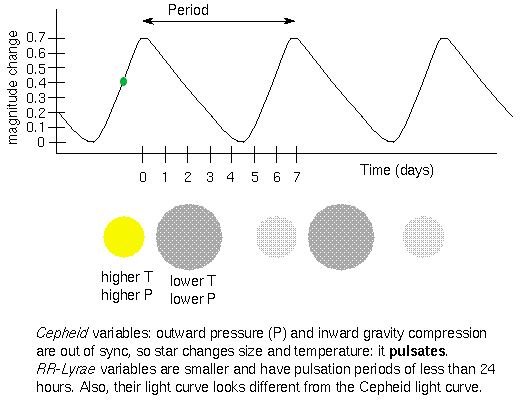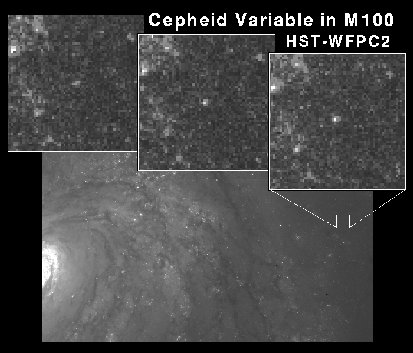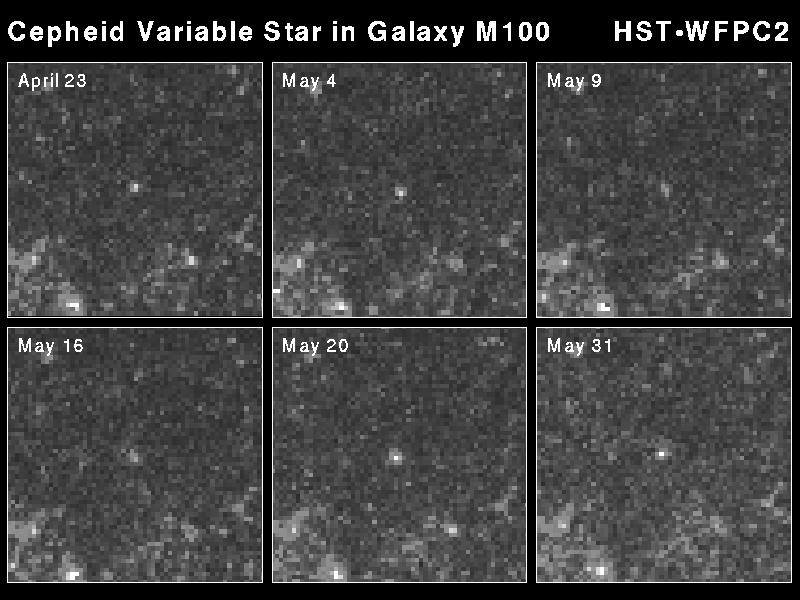
Introduction
The determination of the location of our Sun in the Milky Way galaxy and the size of the Milky Way rested on the determination of the distances to the markers used to map the Galaxy. To determine distances to observed objects one must have an independent method by which to estimate their true brightnesses (intrinsic power outputs, i.e., their luminosities). Shapley in his study used the pulsating variable stars known as RR Lyrae stars taking advantage of the relationship between the period of variation and the intrinsic brightness of RR Lyrae stars and Cepheid variables discovered by Henrietta Leavitt of the Harvard Astronomical Observatory.
Stars such as Cepheids and RR Lyrae stars that vary regularly in their outputs are called variable stars. A variable star is unable to find the proper balance between the energy welling up in its nuclear furnace in its core and the power radiated from its surface. Initially as energy is released in its core, the star is compact and is unable to radiate the energy and heats. This forces the internal pressure in the star to build up causing it to expand in size. The expansion puffs up the outer layers of the star allowing the heat to leak out; the star is thus able to release some of the built-up pressure and the star contracts. In its efforts to find a stable equilibrium, the atmospheres of pulsating variable stars alternately expand and contract, causing the star's luminosity to rise and fall. The figure below shows a typical plot of the output of such a star as a function of time (the star's light curve),

The period between peaks in luminosity is easily mesured from such light curves. These periods range from several hours to several months. Cepheid vairables vary in output with periods of a few days to a few months.
Once the period of a Cepheid variable is determined, the period-luminosity relation yields its intrinsic power output (its luminosity) and its distance may then be found using by comparing this to its obseved brightness.
Cepheid measurements provide distances to nearby galaxies and calibrate the Tully-Fisher relation, as most other galactic distance indicators.
1. We will first construct a period-luminosity relation based on the following table of Cepheid periods, distances, and luminosities. Note--for historical reasons the luminosity (POWER) of Celestial Objects is based on something known as the magnitude system (Section 17.2 and the box More Precisely 17-1 in the text) which has its origins with the Greeks. The magnitude system is a measure of the luminosity of an object given by
Magnitudes are defined such that the brighter an object, the more negative is its Magnitude. Rewriting the definition for absolute magnitude M, we find
From the following list of Cepheids, plot the Absolute Magnitudes, M, of the Cepheids versus their periods of variation, P.
Comment. We will make the plot in a nonstandard manner in that we will plot the period P versus the Absolute Magnitude, M. The vertical axis is logarithmic on the sheet of graph paper. Note the uneven spacing of the tick marks. Start with period P = 1 day at the bottom and then increase P upward to 1,000 days at the top. The scale on the horizontal axis is linear, evenly spaced tick marks. The Absolute Magnitude, M, will run across the horizontal axis. Relabel the tick marks to run from 0 to -10.
|
 |
2. Draw a line through your plotted points to indicate roughly how the Absolute Magnitude of a Cepheid depends upon its period of variation. The trend of the plot says that Cepheids with (LONGER/SHORTER) periods of pulsation have (GREATER/SMALLER) intrinsic luminosities.
3. The galaxy M100 contains Cepheids which help us determine the distance to M100,
 |  |
The images were taken with NASA's Hubble Space Telescope of the spiral galaxy M100. The images were taken in visible light in 1994. The Cepheid in the picture varies in brightness by around a factor of 2 with average apparent magnitude m ~ 24.8 with a period of variation of 51.3 days. Use the period to find the absolute magnitude M of the Cepheid from your period-luminosity relation. What is the absolute magnitude M for this Cepheid? _______________ .
4. Using the average apparent magnitude m and M, find the distance to M100 by use of the relation given in the box More Precisely 17-1, page 458 in the text,